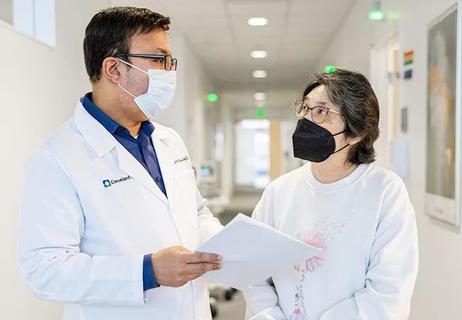Cleveland Clinic is a non-profit academic medical center. Advertising on our site helps support our mission. We do not endorse non-Cleveland Clinic products or services. Policy
One of the great unmet needs in breast cancer diagnosis is a noninvasive imaging technology that accurately predicts whether a lesion is cancerous or benign.
Currently, many women with a suspicious breast lesion require a biopsy. Yet, of the 1.7 million core needle or surgical breast biopsies performed each year in the United States, more than 70 percent yield benign findings.
Investigators at Cleveland Clinic and several other leading breast imaging centers are participating in an observational study evaluating a new imaging technology that may better predict which breast masses are cancerous and which are benign.
The Imagio® breast imaging system is based on the technology of opto-acoustic imaging (OAI). “It is a combination of optical imaging, which is light, and sound imaging, which is ultrasound,” says Stephen Grobmyer, MD, Cleveland Clinic’s principal investigator for the clinical trial, Director of Surgical Oncology and Director of the Breast Center. “That combination gives a unique way to look at tissue.”
Instead of radiation, the technology sends pulses of safe near-infrared light that penetrate breast tissue. The light creates sound waves within the tissue that are detected by an ultrasound transducer.
The Imagio OAI system currently under study at Cleveland Clinic and other sites uses two specific light wavelengths. At one of these wavelengths, the strongest absorber of light is oxygenated hemoglobin. At the other, deoxygenated hemoglobin absorbs the light most strongly.
“When you use those two different wavelengths, you can create a map of oxygenated blood and deoxygenated blood within tissue,” Dr. Grobmyer explains. “This technology is providing us with functional imaging based on the amount of oxygenated/deoxygenated blood within a lesion and provides us with information about metabolism and oxygen exchange without using any contrast agent at all.”
Cancerous tissue tends to have a higher metabolic rate and extract oxygen from blood more readily than does normal resting tissue. The combination of hemoglobin concentration and relative oxygenation is intended to aid differentiation between malignant and nonmalignant lesions. “We are hoping that by looking at the pattern of oxygenated/deoxygenated blood, along with the image of the lesion, we can better predict which masses are more likely to be cancerous and non-cancerous,” he says.
The PIONEER-01 Pivotal Study of the Imagio system is a multicenter investigation that aims to enroll 2,000 patients. Cleveland Clinic intends to enroll 165 patients in this study — patients with breast lesions classified via ultrasound as Breast Imaging Reporting and Data System (BI-RADS) 3 (recommended to have short-term follow-up) and BI-RADS 4 and 5 (requiring biopsy).
Women participating in the trial undergo imaging with the Imagio system before anything further is done. Their imaging information is sent for evaluation by radiologists who are not associated with the patient’s clinical care. If a study participant has a biopsy, her Imagio results are then compared with the pathology results to determine correspondence. Patients who do not undergo a biopsy are followed for a year, after which they receive a follow-up OAI evaluation. The presumption is that if a lesion is stable at a year, it is unlikely to be cancerous.
OAI is not intended to be a first-line screening tool at this time. “It has to be a focused study where you find a lesion on an ultrasound or mammogram and then home in on it with this imaging device and just look at this area,” says Dr. Grobmyer. “The goal is to reduce the number of benign biopsies being done. It is a high bar because you can’t afford to miss a cancer. That is the challenge with any technology like this.”
But preliminary statistical studies indicate that OAI may have the potential to define a subset of patients who may not need biopsy. The PIONEER-01 trial is the first prospective clinical study of the technology on a large group of women. Says Dr. Grobmyer, “If this works out, instead of going to biopsy, in many cases we could apply this technology and inform the patient right then and there that there is no chance of cancer, and she can go home with no need for further work-up.”
Image courtesy of Seno Medical Instruments, Inc.

First-of-its-kind research investigates the viability of standard screening to reduce the burden of late-stage cancer diagnoses

Study demonstrates ability to reduce patients’ reliance on phlebotomies to stabilize hematocrit levels

Findings highlight an association between obesity and an increased incidence of moderate-severe disease

Cleveland Clinic Cancer Institute takes multi-faceted approach to increasing clinical trial access

Key learnings from DESTINY trials

Gene editing technology offers promise for treating multiple myeloma and other hematologic malignancies, as well as solid tumors

Study of 401,576 patients reveals differences in cancer burdens as well as overall survival

Enfortumab plus pembrolizumab reduced risk of death by 53% compared with platinum-based chemotherapy